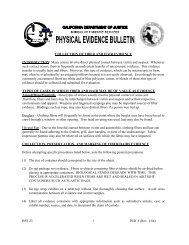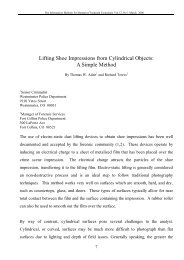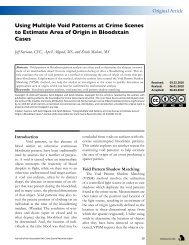PHYSICAL EVIDENCE MANUAL - Crime Scene Investigator Network
PHYSICAL EVIDENCE MANUAL - Crime Scene Investigator Network
PHYSICAL EVIDENCE MANUAL - Crime Scene Investigator Network
You also want an ePaper? Increase the reach of your titles
YUMPU automatically turns print PDFs into web optimized ePapers that Google loves.
Physical Evidence Manual<br />
Adopted: May 2002<br />
Revisions: 6<br />
Last Revision: January 31, 2008<br />
13.0 GLASS <strong>EVIDENCE</strong><br />
Glass is one of the more important types of physical evidence that is commonly<br />
overlooked. Glass is frequently encountered in burglaries and hit and run cases,<br />
and glass fragments may be found adhering to garments, shoe soles, or other<br />
property belonging to the suspect(s) as well as in hair combings.<br />
Glass evidence cannot be individualized to a single source, however, there are<br />
some instances where two fragments can be physically matched together and a<br />
common origin can be conclusively established.<br />
Glass examinations may reveal the following:<br />
• Whether or not evidence glass is similar to glass from a known source<br />
• The type of glass (e.g. tempered glass, container glass, etc.)<br />
• The direction of force (from inside or outside) used to break a window<br />
• The order of shots fired into a window or windshield<br />
Consider that large glass pieces may have latent fingerprints present and the<br />
broken edges of glass may have other trace evidence present such as blood,<br />
hair, or snagged fibers.<br />
Collection and Packaging of Glass Evidence<br />
• Collect and submit all glass pieces if you believe numerous glass pieces<br />
were from the same object (e.g. a window, a bottle, vehicle headlights,<br />
etc.) and request the laboratory to attempt a physical match.<br />
• Package glass pieces from different locations into different containers,<br />
clearly marking the outside packaging as to the location and description of<br />
the evidence.<br />
• Label large glass pieces with orienting marks (e.g. up/down,<br />
inside/outside) when applicable.<br />
Large Glass Pieces<br />
Collect and package a large glass piece in a rigid container such as a cardboard<br />
box. Protect the broken or fractured edges of the glass from any additional<br />
damage or breakage.<br />
13-7














